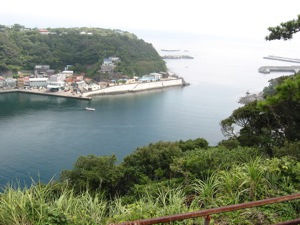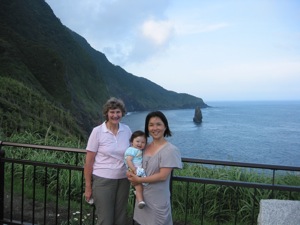
October 14th 2008
Well, the world economy seems to have got a bit better over the weekend. Mind you, if someone gave me trillions of dollars, I'd feel a bit better, so maybe it isn't too surprising. At any rate, it makes updating my diary more appropriate, so I'd like to finish the account of our trip to Izu Ohshima today.
On the Tuesday, we decided to visit the remaining tourist sites, and complete a drive all the way around the island. The main road is called the "Island Ring Road", which does rather invite you to try it out. We went anti-clockwise, and the first place we stopped, briefly, was a place were a whole set of rock strata are exposed by the side of the road. Each layer represents an eruption of the volcano, although there is one layer that represents an eruption of a different island, quite a long way south. It's really quite a spectacular sight, because the exposed strata continue for some way. I wondered whether they were exposed by the construction of the road, but none of the explanatory material said so.
That was really just a place to stop briefly on the way, and the first main stop was Habu.
Habu
 Habu port
Habu port
Habu is a port on the southern coast of Ohshima. Until a few hundred years ago, it was a lake in an extinct volcanic crater. Then there was an earthquake, and part of the wall collapsed, turning it into a nice sheltered bay. As you can see from the picture, there are very steep slopes all around the bay, as you might expect, and quite a lot of the town is on top of the old crater, rather than down by the water. These days, it's a quiet little town, but about eighty years ago it was bustling. We went to have lunch at a sushi place down near the waterfront, on a street that hasn't changed much in appearance since the Taisho and early Showa periods (1920s and 1930s). According to the woman in the sushi shop, it's not a very convenient place to live, but it was very nice sushi.
In the shop, there was a photograph of the bay at the height of the town's prosperity. The whole bay was full of fishing boats. Apparently, the nearby sardine fishery was so productive that a boat could go out once and earn enough money to keep the crew in parties for the rest of the year. Of course, it was overfished and collapsed, and Habu isn't as popular as it was. At the time, however, it was famous for its entertainers, like geisha only not quite so exclusive (given that they were entertaining captains of fishing boats rather than captains of industry). Indeed, a very famous novel of the early twentieth century, Izu no Odoriko (The Dancing Girl of Izu), is about the relationship between one of the dancing girls and a young man (17 years old) who was studying at one of the elite high schools of the period. The special express trains to the Izu peninsular are called "Odoriko", after the novel, even though they don't go to the island, and the area of Habu where the ryokan were concentrated is called "Odoriko's Hometown".
There are a couple of "museums", one of which is a former ryokan. I put "museum" in scare quotes, because it's really just the building. The ryokan does have some life-size models to give an idea of what it would have looked like, and one set played music and danced if you pressed a button, which let me surprise Mum and Yuriko. Another building, on top of the cliff, was really just the building: the home of a wealthy and influential family, which raised silk worms in the loft. The house was quite large, with a very western-style gate and a very elaborate toilet, in white porcelain with blue decorations, but I'm not sure that it would be a very comfortable place to live now, even if it weren't a museum.
Fudeshima
The plan was to visit Fudeshima next, and then continue round the island. Unfortunately, a rock fall had blocked the circular road, so there was a diversion. You could go just as far as Fudeshima on the circular road, but to get there you had to go quite a long way past the point where the diversion started. We worked that out after going some way along the diversion, so getting to the spot was a bit of a performance.
 My mother, wife, and daughter, in front of Fudeshima.
My mother, wife, and daughter, in front of Fudeshima.
"Fude" is Japanese for a brush pen, and the island is so-called because its shape is reminiscent of the brush. It's just a rock poking up in the bay, so you can't go there, but the view was very pleasant, and the closed road meant that there was no traffic, so we stayed there a bit.
One odd thing we saw was a large white cross a bit below us, on a headland. While we were still enjoying the view a couple of locals came up from a walking trail, and told us that we could drive down to the sea, and then look at the cross. The road down there was more of a path, only just wide enough for a single car. I dread to think what would happen if you met someone coming the other way. Stil, Yuriko got us down safely.
When we went to look at the cross, there was a moment of confusion, as the signs seemed to be claiming that the cross was a kami. A little bit of further investigation cleared up that mystery; there is a small shrine a bit further along the headland, behind the cross, and that is the kami. The cross itself is a memorial to one of Tokugawa Ieyasu's serving women, who converted to Christianity in the early seventeenth century and was exiled to Ohshima. As punishments for being a Christian at that time go, it was very mild, and eventually she was exiled a bit further, to Kozushima, some way south.
Because the beach at Fudeshima is a swimming beach, it has all the facilities: toilets, changing rooms, showers, and a disabled toilet with a full baby-changing table. That meant that we were able to get Mayuki changed, which was something of a relief, as well as a surprise; we really hadn't expected to find such a thing all the way out there.
The drive back to the ryokan would have been very pleasant, if Mayuki hadn't decided that she was deeply unhappy with something and cried most of the way. We stopped at the Ohshima Park car park and fed her, but that didn't quiet her for long. We all survived until we got back, and Mayuki calmed down once we could hold her rather than leaving her in the child seat. That evening, Mum looked after Mayuki while Yuriko and I went out for dinner together, just the two of us, which was very nice. When Mayuki gets a bit older, we might be able to do it more often.
Ohshima Zoo
On the last day, two of the places we wanted to go to were shut for that day, so we went back to Ohshima park and visited the zoo. That was a very interesting experience, because it is being redeveloped. The first part we went round was the old part, with rather bored-looking animals in uninteresting enclosures. But then the path brought us to the new part, with a petting zoo, a red panda with a full activity centre, and a large enclosure with lemurs and mountain goats sharing a rocky island. Once they've finished redeveloping the whole thing, it should be a really nice zoo. It's run by Tokyo Prefecture, and admission is free, which makes it even better.
Mayuki did seem to notice some of the animals, but I think she's still a bit too young to properly enjoy a zoo. She hardly seemed to notice when two giant tortoises started having sex right in front of her. That was a bit surprising.
We headed back to Motomachi to eat lunch, which was very nice, even though Mum was a little surprised to get a whole fish. Then we discovered that our boat was going to be an hour late, which gave us a bit more time to look around Motomachi, including the site of a castle built by a famous twelfth century exile, before we had to hand the car over and get the boat back to the other bit of Tokyo.
All told, it was a really nice holiday, and we all loved the island. Yuriko and I are hoping to go back there with Mayuki at some point fairly soon. Of course, there are also a lot of other places in Japan we want to visit, but Izu Ohshima is actually fairly convenient.